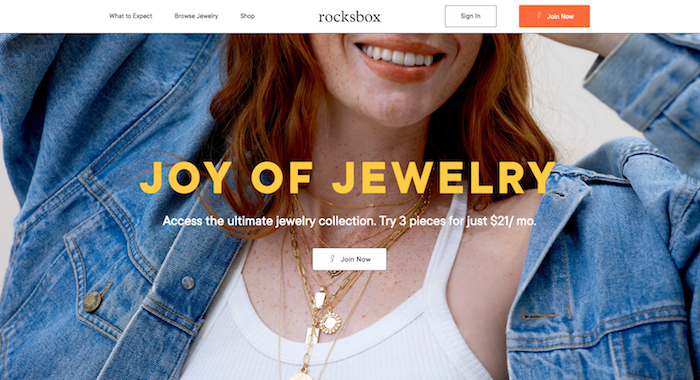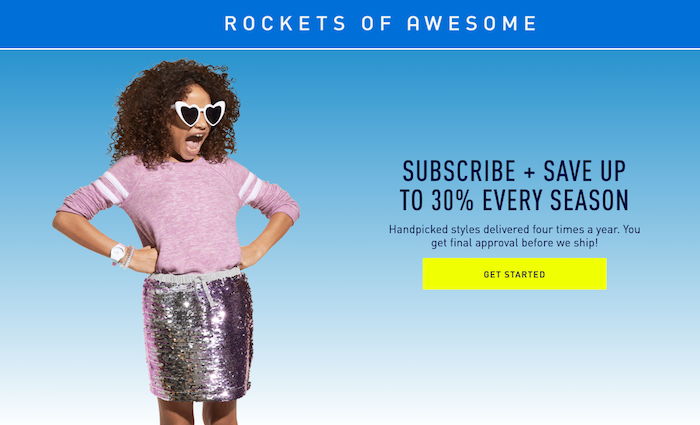Product Subscriptions Can Increase Conversions – If You Get Them Right

Among the biggest challenges ecommerce retailers face is figuring out how to increase conversions, and after people buy, getting them to come back to your online store. This second part – repeat customers – tends to come more easily if you sell products that people need to replenish. (Think pet food, toiletries, and other supplies people continually need.)
The good news is that other product categories – wearable brands, we’re looking at you – have also begun to unlock these challenges through ecommerce subscriptions. Apparel companies, like Stitch Fix and Rockets of Awesome, have led the way by personalizing their inventory and sending unique product assortments to customers via regular deliveries.
For merchants, the benefits of a successful ecommerce subscription program are manifold. First, the very nature of subscriptions is that it’s a repeat purchase. Secondly, subscriptions give retailers the chance to develop long-term relationships with customers. Subscriptions also create the opportunity to place products in front of customers that they may have never considered. And, in the subscription process, merchants learn a great deal about their shoppers, including things like sizing and style preferences.
5 Essential Questions to Answer Before Launching an Ecommerce Subscription Service
Given the tremendous potential of subscriptions, what’s there to lose? Frankly, quite a lot, if they are not done right. When customers sign up for a product subscription, they are expressing the intent to engage with your brand for a long time. If it doesn’t go well for them, not only will you not get the benefits of a strong subscription service, these engaged customers will be deeply disappointed. The stakes are high here.
For retailers ready to start product subscriptions, the best insurance policy is to plan your technical strategy before you begin. Retailers can have a lot of success here, but there’s rarely a simple subscription. Here are five essential questions every retailer needs to ask themselves before launching a subscription program.

1) Do we want to offer standalone products or will we only sell subscriptions?
This is an important decision to make because the answer will determine the customer’s checkout experience.
For example, let’s imagine that you only sell subscriptions for bags of coffee. When customers go to a product details page (PDP) on your site, they click “subscribe,” and a pop-up interstitial comes up that lets them checkout then and there. In this example, you are selling one thing, via subscription, and the customer has purchased only that.
Now imagine if that customer wants to give one of your coffee subscriptions to their friend. So, they want to buy two subscriptions with two different addresses. How do they do that? Plus what if they want to add one of your coffee mugs to their order?
Once merchants get beyond a singular subscription for one product going to one address, you need to get a more sophisticated checkout system in place. Now the checkout process has to handle subscriptions and single purchase items. You always want to give your customers the ability to purchase as much and as easily as possible, so you probably want to add in gifting capabilities at checkout, too. It’s important to consider all the possibilities for your subscription service. The goal here is to increase your conversions. If you sell a variety of products, it’s key to not limit customer selection.
2) What tech tools will we use to support our subscription business model?
Once you know your business model, e.g. subscriptions only vs. subscriptions plus other types of sales, that begins to inform the best backend tools for the job. Start by exploring what kind of subscription support comes natively in your ecommerce platform. You may be able to leverage some out-of-the-box platform features.
More commonly, however, retailers will need to integrate a third-party app or service to help manage subscriptions. Apps like Recharge and Paywhirl are great options to consider. At the same time, keep in mind that merchants’ plans will vary. This isn’t one-size-fits-all. That said, first see what’s possible using the tools that you already have in place, like your ecommerce platform. Then, based on your strategy, determine whether you need additional features to make subscriptions happen as you want.

3) How will we handle expired credit cards (and other customer changes)?
This question may sound very specific, but it’s a big one. Credit card glitches point to a much larger issue in ecommerce subscriptions: dunning management. Dunning management refers to the way that a retailer handles payment failures and declines. With subscriptions, it’s tempting to want to “set it and forget it,” but customers are always in flux. People change addresses. They have to get a new credit card because of ID theft. Or credit cards expire. You name it, there are numerous reasons why a customer’s payment last month will not work this month. You have to be prepared to handle the reality of frequent customer updates.
4) How will our customers update their information?
Broadly speaking, the answer to how you’ll handle people’s changing information, including payment methods, will be in how you let people update their online account.
From a technical perspective, you have to give customers a place to login and make changes. Not only will this be for things like updating addresses, but it should also accommodate people’s preferences. For example, what if someone is out of town, and they want to skip this month’s subscription? Or they want to change the frequency of their deliveries? Or they never want to get shoes in their subscription box again? Retailers want to empower customers to communicate their information and preferences as much as possible.
Additionally, you want to plan out how your operations team will receive these updates and accommodate them. For example, the app, Recharge, coordinates the basics of account management. It handles the actual subscription, the charging of a customer’s credit card, and more. It also has an API. With the API, your development team can build a custom application that both leverages all the capabilities of Recharge and connects into your operations. This would then allow you to customize how your subscription updates are processed so that it works best for your fulfillment and shipping team.
5) How will our operations team handle subscription fulfillment?
Simply stated, you do not want to completely upend and rebuild your operations in order to start selling subscriptions. The bulk of the technical work required to make subscriptions happen from the operational standpoint should probably happen between the time the order is placed and the ERP receives it. Sometimes retailers then build subscriptions into their ERP or warehouse management system, and these programs interact directly with the subscription to know what to send. If you’re starting a subscriptions-only business – and you’re starting it from scratch – this is often a great set-up.
If you’re not starting from scratch, it would make more sense for the subscription tooling that you choose to actually create what looks like a single-use order. Additionally, it should only create that order after the payment has been received. With this structure in place, you can mold your subscriptions into the process that you already use for fulfillment. As a result, you get to use your existing tools as much as possible as you build out your subscription service. This allows for trial and error without overly investing in new (and untested) technology.

Connecting Your Subscription Business Model to Your Operations Plan
Ecommerce product subscriptions have the potential to increase conversions and create strong ties with repeat customers. But remember, subscriptions will also bring some surprising complexity to your business. You want to get a strategy in place for handling the ever-changing nature of customer information. With this in mind, you’ll then want to give your customers the tools they need to update their accounts on their own. But it doesn’t stop there – your operations plan for subscriptions will be critical to their success. Often a technical discovery process is needed to help articulate your needs clearly and establish a plan of action.
